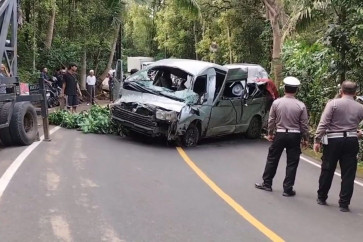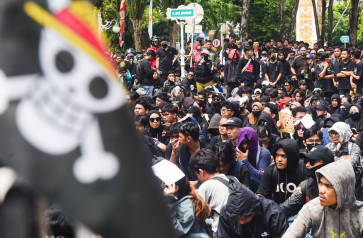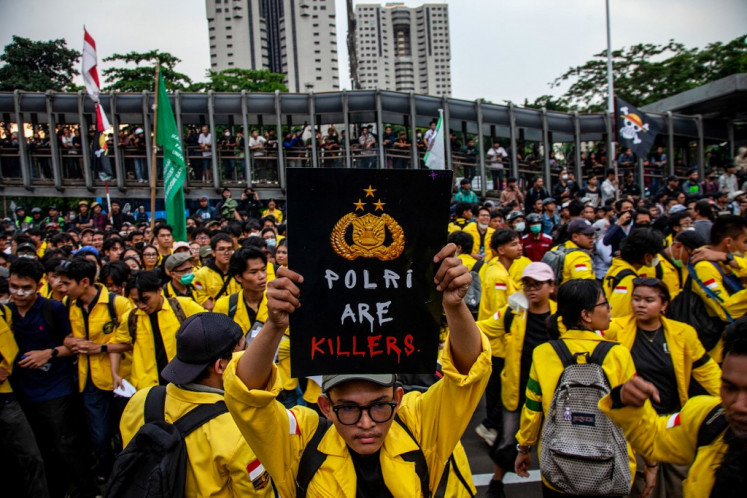Popular Reads
Top Results
Can't find what you're looking for?
View all search resultsPopular Reads
Top Results
Can't find what you're looking for?
View all search resultsWander Lust: A river runs through it
Greening is the now color for Corporate Social Responsibility (CSR) projects – provided the manicured park is well exposed for the company’s care to be advertised
Change text size
Gift Premium Articles
to Anyone
Greening is the now color for Corporate Social Responsibility (CSR) projects – provided the manicured park is well exposed for the company’s care to be advertised. But for closeted kampongs forget CSR. Duncan Graham reports on a Do It Ourselves deal that organizers want others to see and follow:
Civilizations benchmark their birth with momentous events. Muslims use AH Anno Hegirae, the year of Hijra when the Prophet went from Mecca to what is now Medina.
Christians favor BC (Before Christ) and AD (Anno Domini), the year of the Lord.
Secular scientists prefer BP (Before the Present). For Indonesian environmentalists this stands for Before Plastic when wrappings were organic.
“Getting people to stop using our rivers for their rubbish is difficult,” admitted community leader Nurcholis. “We hang signs everywhere. We talk about it whenever we can. But we cannot use laws and threats. They don’t work.
“The way is to go gracefully and set an example.”
Nurcholis and his colleagues have followed his advice. He heads the largest of eight RT (Rukun Tetangga — neighborhood administration units) flanking the Amprong River in Kedung Kandang on Malang’s outskirts.
Last October after months of discussion they made a big decision: to tackle the eyesore levee built long ago to flood proof their kampong. The depressing sight greeting riverside residents was a long, barren, dusty and rubbish-strewn barricade.
Massive river-taming by the Irrigation Department in the 1980s with rock and concrete walls had largely eliminated the need for the levee. The last flood was in 1995 but the ugly earthworks were too big to shift.
Kedung Kandang doesn’t belong in the nation’s much-hyped middle class luring investors. This is Struggle Street, Forgetville where no incomes are disposable. But that doesn’t mean its tenants don’t deserve a decent environment.
Though no local had ever wandered the world’s glamor waterfronts, why not turn the embankment into an educational area and promenade like Shanghai’s Bund or Singapore’s Marina Bay? Maybe even the Left Bank in Paris minus the bars and hedonism for this is East Java and “99 per cent” of the kampong’s 800 are Muslim according to Nurcholis.
It seemed like a good idea at the time. It was.
Winning a Rp 16 million (US$1,225) government grant for cement and bricks helped. So did labor supplied by soldiers drafted to provide kerja bakti (community service). Then followed the ancient principle of gotong royong (citizen self help).
Hundreds scrounged and recycled for playground gear, gazebos and park benches creating style inconsistencies that are more amusing than annoying. Time in the shade can be spent guessing the provenance of renovated iron and painted pipes, paving slabs and split bamboo.
Lion statues are a favorite as locals are 100 percent backers of the Arema Football Club with its Leo symbol. There’s even a Hindu-style sculpture.
Professional park managers frequently favor monoculture flower beds in geometrical shapes rare in nature. But here the donated bushes, flowers and trees have come from everywhere to make a rich mix.

The other factor, whispered rather than shouted in a cooperative project, is the creative competition between RTs.
The park is never more than 10 meters wide. It meanders for about 400 meters with individual sections marrying, though there’s no sameness. Everyone knows who did what and how good it looks.
Agus Surahman, a RW (rukun warga — a step up from RT), said no commercial companies had offered to assist, so no advertising making their secluded park unusual.
High visibility parks in Malang have been sponsored by cosmetic and food companies — ironically even a tobacco factory — keen to link their products with healthy lifestyles.
“When there’s an event we collect Rp 10,000 (80 US cents) from each family to pay for costs,” Nurcholis said. “People who live here are drivers, factory workers and cleaners, but some have made bigger donations – including four boats.”
For Rp 15,000 (US$1.15) an hour families and couples can have a row on the river and enjoy the ambience as the fashionable do in London’s regal gardens and New York’s Central Park.
By Western standards muddy Amprong is no freshet. It’s not just plastic that’s a problem. Cemeteries dot the riverbanks. Road waste drains into the river, used daily by people without access to bathrooms, toilets and laundries.
Fortunately heavy wet-season rains keep it moving. All houses in the kampong are said to use septic tanks, but overflows must reach the river.
Choirul, 32, a coconut drink seller, wants to take the project further with a flying fox across the river and murals on the rockwork.
That way he hopes upriver residents will copy their example: “Then there’ll be less rubbish to pick out when the waters reach us,”
Locals say the do-it-yourself park has reduced friction because there’s space for all activities, including growing vegetable in the river mud. Though no-one says so aloud, the park invites romance. Watching water flow encourages philosophical musings.
“There have been other advantages,” said Nurcholis’ wife Nur Rochma. “Young people now have somewhere to go and things to do. It’s much better here now than hanging around in shopping malls. It’s given our communities a center.”
Food bowl
The Amprong is a major feeder into the 320-kilometer long Brantas, the Nile of East Java.
Second to the 600 kilometer-long Solo River (half in East Java), Brantas is a most curious waterway. Sustained by 1,500 mountain streams and lowland channels known as anak-anak Brantas (children of Brantas), it heads for the Indian Ocean — a logical direction because that’s the nearest exit.
Then it turns west, then north. On maps it looks much like a diagram of the human alimentary canal — which is apt.
After running hither and yon draining a catchment 17 times bigger than Singapore island it empties into the Java Sea near Surabaya.
Brantas sustains mega millions by watering the flatlands it traverses. This is the province’s major food bowl. It also supplies power through nine hydroelectric stations built during the Soeharto years, industrial and household water and fish.
Waeman, 61, who worked for the Irrigation Department for 37 years, said managing flows was “very difficult […] it runs cold but farmers run hot when they don’t get enough water.
“Everyone needs the Brantas and Amprong. As we say, sungai bersih, warga sehat (clean river, healthy people.)”
Outsiders should visit early Sunday mornings when locals set up colorful food and drink stalls; the public is invited to jump up and down to loud music or promenade nibbling a fresh tempe (soybean) cake. The big companies may not be interested but here’s a chance to see how communities can make a difference — and what gotong royong means. Kedung Kandang is 10 km east of central Malang.










